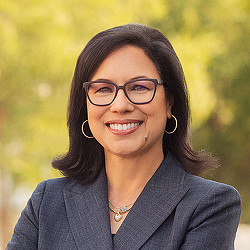Will There Be a Climate Change Vaccine?
May 11, 2020 | By Diane Hoskins
This post was originally published on LinkedIn in May 2020.
Editor’s Note: This post is part of Gensler’s Impact by Design 2020 report and our ongoing exploration of how design is responding to the COVID-19 pandemic.
Crises are not announced ahead of time. Instead, they arrive unexpectedly and without warning. The COVID-19 pandemic, in the matter of a few weeks, went from a trickle of cases to a tsunami of loss and uncertainty. As of today, the human impact is hundreds of thousands of lives, with an estimated economic impact of about 22 trillion US dollars. The toll on human life and economic value is beyond comprehension. The world will never be the same.
One lesson we have learned through this storm is that time matters. The places that reacted quicker to the outbreak with quarantines and shutdown orders were more resilient and resulted in both a less steep curve and better containment of cases.
But what if we knew that the COVID-19 pandemic was on its way perhaps six months to even a year before it arrived? What would we have done to get ready? If we had had this lead time, first of all, we would have put massive resources into finding a vaccine and effective therapies to treat those who would be infected. Secondly, we would have warned people and organizations to stockpile food, medicine, PPE, ventilators, and other necessities. Third, we would have developed emergency management operations strategies, involving the business community, on how to stage the appropriate shutdowns and coordinated quarantines along with an underlying economic strategy.
While we didn’t have a warning of the COVID-19 crisis, we do have a warning about the climate crisis up ahead. The $22 trillion impact of the COVID-19 pandemic will likely be matched and even surpassed by climate change. This can only be avoided if we create the analogous vaccines, therapies, and business strategies to “flatten the curve” of coastal sea-level rise and warming of our cities to the point of being uninhabitable during portions of the year. We actually received the warning, and in a timely fashion. We got it 50 years ago.
We just celebrated the 50th anniversary of the first Earth Day. Fifty years ago, there was a call to action about something that was happening to our air, water, and land, which was harming people. If left unchecked, we were told it would make our planet a difficult place to live in the future.
In 1970, the year 2020 seemed far enough away, and certainly 2050 was beyond the expected lifespans of the zealous hippies who protested and marched on the first Earth Day warning about the approaching storm. But 2050 is now only 30 years away, and the likelihood of severe consequences from climate change will indeed be felt by then.
The likelihood of coastal flooding issues, heating of cities in the southern hemisphere, super-sized storms, megadroughts, and all of the ecological, zoological, human health and economic impacts are becoming more of a certainty. The trends have been studied. All the temperatures have been recorded, and we can see the ice caps melting. We are witness to the Great Coral Reef being bleached by the hot sun; a rare occurrence that is becoming an annual event.
We know that the COVID-19 pandemic will end in the next 6-18 months due to the extraordinary focus of hundreds of doctors and scientists tirelessly working on therapies and a vaccine. It will cost billions of dollars, but there is no cost too high to save humanity.
Can the world endure another C-19 experience? If another pandemic starts, the world will do everything to react quickly and put all the right actions in place. We won’t have to wait until it is out of control to respond, we will not hesitate to act, and act fast. Unfortunately, the climate crisis is not a pandemic that a vaccine will cure, and once its most serious impacts set in, there will be escalation and cascading of impacts rather than a race for the cure. The $22 trillion GDP cost of the current pandemic is gut-wrenching, but imagine that level of impact becoming an annual headwind. Contrary to the uncertainty around the next pandemic, there is a certainty with climate change. Hundreds of computer simulations, thousands of scientists and reams of physical evidence are pointing to the affirmative.
The advantage today is that we still have the power of time. Regarding climate change, we can act now and implement the strategies to slow the rise of global warming. We can find ways to increase the natural immunity of the earth by growing trees and other natural carbon-sequestering organic material. We have to change our buildings, our cars, our factories and our farms—all possible and plausible.
Gensler is the world’s largest architecture and design firm that approaches climate change from the mantra of future now. Between our 5,000 global clients across the globe, we design over 1.5 billion square feet of work each year. As noted in our annual resiliency assessment of our portfolio, Impact by Design, when someone of our scale makes changes, the effects are felt across other sectors.
With the built environment, incorporating the latest sensors and smart technology, along with the use of innovative systems and materials, can help propel real and meaningful climate action. When we decide to use carbon-friendly materials for all projects, it has a ripple effect and we change the way our suppliers and vendors conduct business with others in real estate development.
The world has changed and it will take more than just reacting quickly. The current situation has shown us that time, and what we labeled as the future, is actually right now. In the fall, when Gensler issued our charge to ourselves, and the industry, to eliminate all greenhouse gases associated with the built environment 20 years ahead of the Paris Pledge goal, it was made with the idea that we should prepare today for when our future would catch up to us.
Timing is everything. A major event has the ability to collapse time to a specific moment. That moment is now, and now is the time to seriously think about getting ahead on climate change.
Follow Diane on LinkedIn for more insights on the trends and topics defining the future of cities. For any media inquiries, please email .

